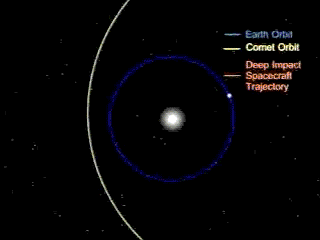Encounter Animation 1
This video clip represents the original launch date for Deep Impact which was January 2004. Under that schedule, the twin spacecraft would have taken one year to orbit the Sun. As it passed the Earth in January 2005, it would have used the moon to test its instruments before heading to Comet Tempel 1. The one year orbit has been replaced by further testing on the ground prior to launch. The two-part spacecraft was launched in January 2005, and will travel directly to the comet.
(This video was produced prior to the change in launch date. Deep Impact was successfully launched on 12 Jan 2005.)
|
|
Available formats:
|
Original Caption: The two-part spacecraft will launch on January 2004 and take one year to orbit the sun. As it passes the earth in January 2005, it will use the moon to test its instruments before changing its trajectory to head toward Comet Tempel 1. In July 2005, the Deep Impact spacecraft will arrive at the comet and release a second spacecraft called the "impactor" into the path of the approaching comet. The main spacecraft (flyby spacecraft) will maneuver to a new position to safely watch the comet as it is impacted and flies over the top of the flyby spacecraft. The flyby spacecraft will have about 14 minutes to observe the crater and the ejected material before the comet passes overhead. Once the debris from the comet has cleared, the spacecraft will turn over and watch the comet as it travels off into space. There will be cameras on both the impactor and flyby spacecraft to send visuals back to earth.
CREDIT: Frank Semerano, JPL Media Relations












